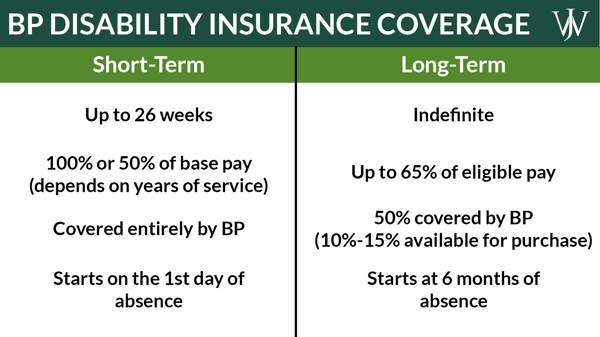It's that time of year again — BP's benefit election time. While Open Enrollment isn't quite as exciting as the holidays or the New Year, it's likely more important than you realize. Before you get too busy and default to the same elections you made last year (and maybe the years before that), I urge you to take a minute to understand how these benefits affect you and your family. Not to be dramatic, but they could affect your financial livelihood. That is a big statement, so let's back it up with the facts of BP election options for 2025. Specifically, this article focuses on your disability insurance options. If you're interested in the other benefits to make elections on during Open Enrollment, check out our articles on BP Life Insurance and the BP HSA plan for medical.
For those of you still here, we often see BP professionals overlooking their disability options and focusing more on life insurance. Of course, life insurance deserves attention for a good reason. However, becoming disabled during your working years can be financially devastating if you aren't adequately covered or prepared. But many people avoid talking about disability insurance. Why? Topics surrounding insurance are uncomfortable. You never want to imagine something happening that will prevent you from working at a job you enjoy. You don't want to imagine ongoing medical expenses and bills. You don't want to imagine being unable to work in any capacity. Are you squirming yet? You never want to need disability insurance, but if something happens, you'll be grateful to have it. Likewise, your family will be thankful you have it. However, not everyone's disability coverage needs are the same. Some can self-insure, while others cannot. The goal here is to ensure you are empowered to decide what's right for you based on the coverage options available at BP.
BP Disability Insurance Coverage: Short-Term Disability & Long-Term Disability
There are two general types of disability insurance: Short-term and Long-term. Per the BP Benefit Book, "The BP Short-Term Disability (STD) Plan provides income protection if you are ill or injured and unable to work," and "The BP Long-Term Disability (LTD) Plan is designed to replace a portion of your pay if you become disabled for more than six months."
BP Disability Insurance Coverage
As an employee, BP pays for basic disability insurance coverage. BP pays the total cost of Short-Term Disability coverage and the full cost of Long-Term Basic Disability coverage. So, one thing you can remove from your growing list of things to do during Open Enrollment is electing the basic coverage. BP does that for you!

BP Short-Term Disability Coverage
BP Short-Term Disability benefits begin on the first day you are unable to work due to illness or injury and can last up to 26 weeks. Your years of service and current base pay determine the amount of short-term disability benefits you can receive.

BP Long-Term Disability Coverage
Because BP fully covers all short-term disability coverage, let's discuss your options for long-term disability elections. Long-Term Disability benefits can provide a monthly income of up to 65% of your eligible pay if you are disabled for longer than six months. Not only does BP offer basic benefits, but it also allows employees to purchase additional insurance. But this is where many people need clarification -- How much, if any, additional coverage do you need to purchase?
Out-of-Pocket Costs for Additional Long-Term Disability Coverage from BP
First, let's review what BP offers complimentary. As you can see, they offer 50% of long-term disability coverage without any employee out-of-pocket costs. But you can also add 10-15% of coverage through a monthly paycheck deduction.

Extra insurance sounds great, but what is it going to cost you? Let's walk through an example:
Suppose you are 46 years old, and your current monthly base pay is $10,000. For no additional cost, your 50% coverage provided by BP would yield $5,000 a month or $60,000 a year for long-term disability. However, let's suppose you added the 10% or 15% of long-term disability coverage, bringing you from 50% coverage to 60% or 65% coverage instead.
60% coverage, or paying for the additional 10% long-term disability coverage, will cost you $13.80 a month. You'd get $6,000 a month and $72,000 over a year. If instead you opted for the additional 15% coverage, totaling 65% long-term disability coverage, you'd pay $25.20 each paycheck. As a result, you'd receive a benefit of $6,500 each month or $78,000 a year.
While these differences may not sound like much, the right amount of insurance could mean the difference between using your hard-earned savings to cover expenses and having the cash flow from insurance to cover them.

How Much Disability Insurance Do I Need?
Let's consider another example to determine how much insurance is the right amount. Peter and Claire are 40 years old with two young kids. They have $300k in investable assets and only one income. As the sole breadwinner, Claire has an annual salary of $250,000 and has worked at BP for six years. Their family expenses equal $100,000 per year. If Claire becomes disabled tomorrow, the short-term disability benefits will begin to payout for a maximum of 26 weeks. Based on the short-term disability chart above, Claire and her family will receive eight weeks of full pay and 18 weeks of 50% pay. Typically, Claire's income in six months of work is $125,000. However, because she is now on short-term disability, she only receives $81,725. That's a fairly significant pay decrease, considering that Peter and Claire still need to pay tax on these earnings, and Claire has higher medical expenses now.
If Claire continues to be unable to work, she will start long-term disability benefits after the initial 26 weeks elapse. She did not elect the BP supplemental offering and, therefore, will continue receiving up to 50% of her base pay on an ongoing basis.
To put this into perspective, let's consider her financial situation after week 26. Her new take-home pay will be $125,000 annually from her BP disability benefits. After taxes, this will not cover their family expenses of $100,000 (this amount does not include the expenses due to disability), so Claire and Peter face some tough decisions. Can they cut annual expenses? Is Peter able to go back to work to bring home additional income? Keep in mind, the most disability insurance you can obtain is 65% of your salary, and that may not be enough for financial independence. Electing an extra 10% or 15% benefit could have left them with additional expense flexibility without putting them in a spot where they cannot cover their ongoing expenses. They could have had the extra coverage for just $20.83 or $38.13 per month. Keep in mind that through most disability insurances, the max you can obtain is 65% of your salary, and that is typically still not going to be enough, so you want to make sure to have maximum coverage available until financially independent
I don't share these examples to scare you and your family into purchasing more insurance. Instead, I encourage you to take a closer look at your financial situation and ask the question: do we need the additional coverage, or can we self-insure the extra 10%-15% of coverage if something unexpected happens? At WJA, we do insurance evaluations like this with our clients to ensure that any potential gaps are covered because no one ever expects these things to happen. However, if something does happen, it's always a relief if you're prepared. Gaps like these are easy to fix during BP's open enrollment period.
Take Action During BP's Open Enrollment Period
BP's open Enrollment is one of the only times you can make changes to existing elections, so it's essential to start thinking about making changes to your elections now. We strongly encourage consulting with a fiduciary advisor before making insurance changes to ensure that you coordinate this strategy with the rest of your financial plan.
Work with a Fiduciary Financial Advisor to Coordinate Insurance and Your Financial Plan
When done correctly, this strategy can make a substantial difference in savings over time. Our firm focuses on comprehensive financial planning and ensuring that evaluating disability insurance gaps is done correctly to help our clients reach their financial goals. Unlike many other firms, we don't sell insurance, so our insurance advice comes with a lower conflict of interest. Instead, we aim to ensure that you have the proper amount of insurance to address your family's needs, not too much or too little. While correctly handling all these financial pieces may seem daunting, you don't have to do it alone. Working with a financial advisor is a beneficial way to determine if this or other tax-efficient savings strategies can help you reach your long-term goals. Start the conversation with an advisor today.








